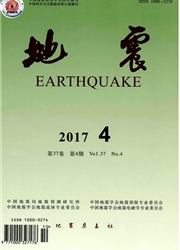

 中文摘要:
中文摘要:
本文对龙门山断裂带南段GPS位移时间序列进行了欧拉基准转换、最小二乘配置插值和滤波分析等数据后处理,并利用块体刚性一弹塑性运动一应变模型计算了龙门山南段各区域应变参数时间序列。结合各站点位移时间序列、速度场及各区域应变参数序列,分析发现2008年汶川Ms8.0地震对龙门山南段的影响由西北至东南由大变小,引起最大变形速度达背景速度6倍,增强了隐伏断层对两侧地表影响的差异,使南段的地震危险性由北至南增加。根据龙门山南段的历史地震及构造背景,对各区域地震危险性进行了比较,发现东南侧危险性最大,历史应变的积累及汶川地震的加速影响导致了芦山地震的提前发生和破裂断层的左旋错动。汶川地震对较远的鲜水河断裂南段也有持续两年的应力微释放影响,但其远不及川滇块体的应力压缩作用。
 英文摘要:
英文摘要:
Methods of Euler datum transformation and least square collocation for data in- terpolation and smoothing are used to process GPS displacement time series data in the southern section of the Longmenshan fault belt, and then we calculated some strain pa- rameters in subareas by the model of rigid and elastic-plasticmotion. Combined analysis of displacement series and velocity and strain parameters revealed that influence of the 2008 Wenchuan earthquake in the southern fault zone enhanced from southeast to northwest and seismic risk along the way, causing deformation accelerating 5 times the most and heighte- ning the influence difference of concealed faults on its two sides. The comparison of seismic risk among subareas based on tectonic and earthquake background indicated that, the most dangerous area is on the southeast edge of the Longmenshan, and the amassed back- ground strain accelerated by the Wenchuan earthquake advanced the happening of the 2013 Lushan earthquake and caused sinistral strike-slip on the rupture plane. The Wenchuan earthquake also caused slight strain release in southern Xianshuihe in the first two years, but far less than strain compression caused by the Sichuan-Yunnan block.
 同期刊论文项目
同期刊论文项目
 同项目期刊论文
同项目期刊论文
 期刊信息
期刊信息
